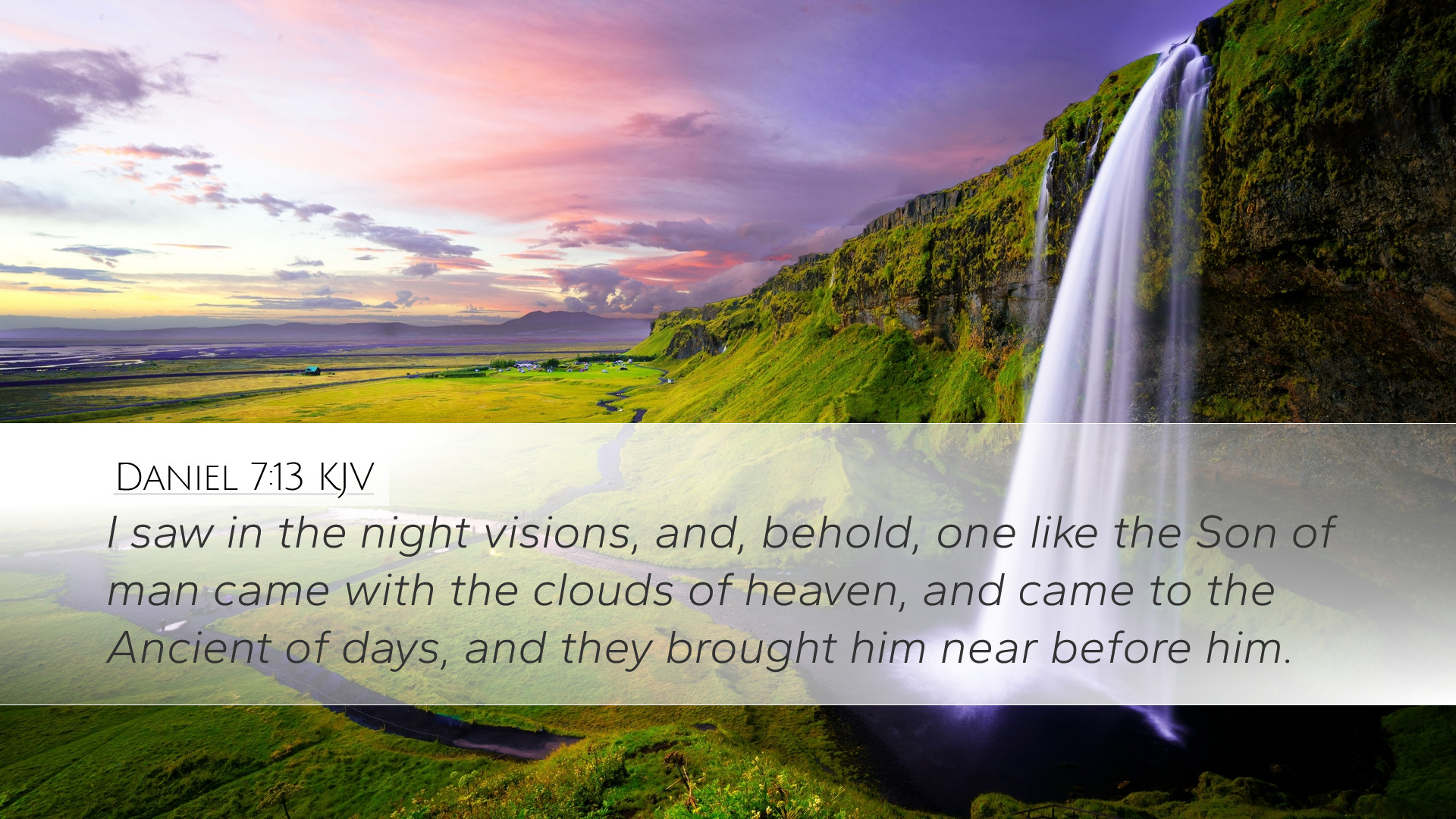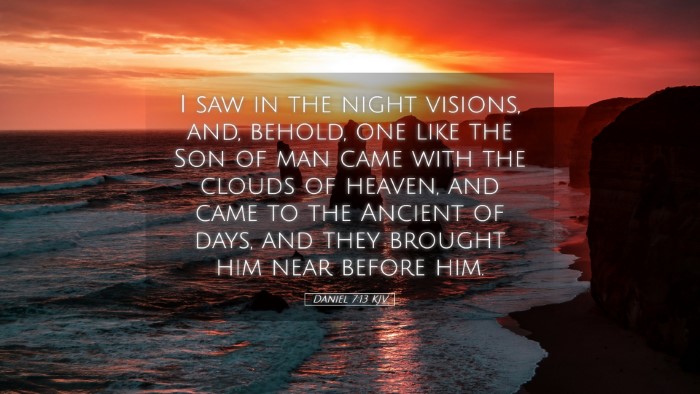Commentary on Daniel 7:13
Introduction
Daniel 7:13 presents a profound vision of the "Son of Man" coming with the clouds of heaven.
This verse is pivotal in understanding both the prophetic and Christological significance in the biblical narrative.
Various public domain commentaries provide rich insights into the implications of this prophecy, which resonates with
both ancient and contemporary theological reflections.
Context and Background
The Book of Daniel is entrenched in apocalyptic literature, encapsulating the struggles and triumphs of God's people amid foreign domination.
Daniel 7 is particularly notable for its imagery of beasts representing kingdoms and the sovereign reign of God that follows.
This verse specifically emphasizes the appearance of a messianic figure and serves as a turning point in the narrative that addresses
divine justice and the final establishment of God's kingdom.
Verse Text
Daniel 7:13 (KJV):
"I saw in the night visions, and, behold, one like the Son of man came with the clouds of heaven,
and came to the Ancient of days, and they brought him near before him."
Analysis of Key Phrases
“One like the Son of Man”
This phrase is pivotal in revealing the identity and nature of the figure in question.
Matthew Henry remarks that the title 'Son of Man' is significant as it binds the figure with humanity, emphasizing the
incarnation and the relatable nature of the Messiah.
It signifies both His humility and His authority, reflecting the duality of Christ's nature, being fully divine and fully human.
“Came with the clouds of heaven”
The imagery of clouds invokes a sense of divine majesty and glory, often associated with God's presence (Exodus 19:9).
Albert Barnes elucidates that clouds symbolize divine power and sovereignty.
They are also a recurrent theme in biblical eschatology (Matthew 24:30; Revelation 1:7), illustrating that this figure comes
not in human insignificance but in divine authority, aligning with the New Testament presentation of Christ’s ascension.
“Came to the Ancient of Days”
The term “Ancient of Days” signifies God's eternal and unchangeable nature.
Adam Clarke highlights that this phrase depicts God in His timeless essence, ruling with infinite wisdom and justice.
The coming of the “Son of Man” to the Ancient of Days suggests a formal acknowledgment of His authority and the establishment
of judgment, reinforcing the theme of divine appointment in the face of earthly kingdoms.
“They brought him near”
This phrase indicates a divine approval and a special closeness to God.
Matthew Henry comments on how this demonstrates the recognition of Christ’s unique position and the affirmation of His
role within the Godhead.
This movement can be interpreted as the culmination of the plan of redemption, where the Son is given dominion and power,
emphasizing His kingship over all creation.
Theological Significance
Daniel 7:13 is a foundational text in understanding the messianic role of Jesus Christ.
Both Henry and Barnes agree that this prophecy points forward to the New Testament, where Jesus refers to Himself
as the 'Son of Man' (Matthew 8:20, Mark 2:10).
This continuity between the Old and the New Testaments highlights the divine plan of redemption
and the affirmation of Christ's authority as sovereign over all.
Christological Implications
The relevance of this verse extends profoundly into Christology.
Adam Clarke indicates that the acknowledgment of Jesus as the ‘Son of Man’ holds great significance in establishing
His role as the mediator between God and humanity.
The coming of Christ with clouds is also a reference to His eventual return, portraying the assurance believers hold regarding
His second coming and the final judgment.
Application for Believers
For pastors, students, and theologians, the rich prophetic imagery of Daniel 7:13 serves as a reminder of God's sovereignty
and His ultimate plan for redemption through Christ.
The truths of this passage have applicational weight for living in obedience to God's kingdom, encouraging believers to persevere
in faith amid trials, echoing the assurance that the 'Son of Man' reigns supreme.
Conclusion
The vision presented in Daniel 7:13 opens a window into the profound majesty and mystery of God's redemptive plan through
Jesus Christ.
The public domain commentaries by Matthew Henry, Albert Barnes, and Adam Clarke provide an enriching tapestry of insights
that illuminate the prophetic anticipation of Christ's coming and reign.
As we ponder this verse, may it inspire deeper devotion and anticipation for the fulfillment of God’s ultimate purpose
in the establishment of His kingdom.


